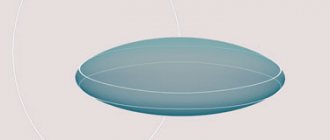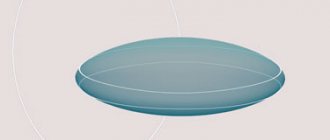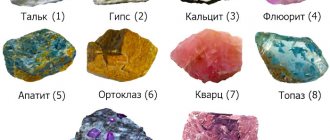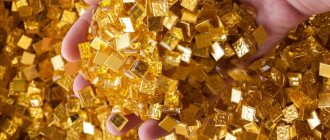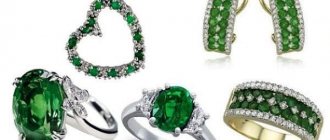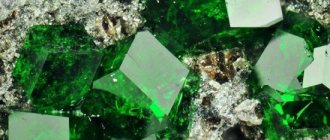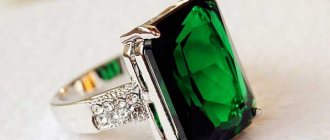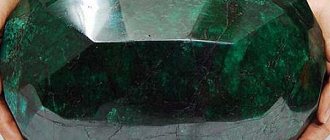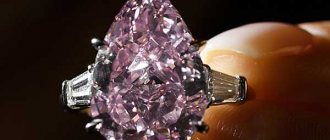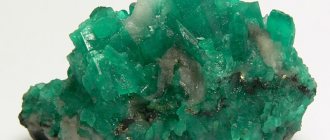Hello, dear readers! Emeralds have attracted the interest of mankind since ancient times; even the rulers of Egypt loved not only jewelry made from them, but also preferred to wear clothes inlaid with them. This type of beryl is not found in nature as often as diamonds, so their prices are often higher. Unfortunately, unscrupulous craftsmen take advantage of this and try to pass off other cheaper stones as gemstones, so the table of emerald purity can help you understand where the real nugget is and where it is an imitation.
How to correctly assess cleanliness and size
In the global community of jewelers, there is a special classification of emeralds based on color and clarity. Ordinary people also, when purchasing jewelry with inserts of these precious stones or just semi-precious stones, should know how to evaluate the size, clarity and cut of the mineral:
- First of all, it is necessary to check for the presence of various inclusions in the nugget.
A real stone, even an artificially grown one, will contain inclusions of gaseous bubbles, crystals, etc. They can be viewed with a magnifying glass. It is worth noting that specimens with an excessive amount of inclusions are cheaper, since this reduces their purity and transparency.
- Next, you should pay attention to the cut of the mineral. Cutting green beryl is a very labor-intensive process, since due to inclusions the stone can be quite fragile and simply crumble.
Green gems are most often cut into rectangular shapes. The gem must be cut in such a way as to protect the crystal from damage during use. A high-quality cut enhances the natural qualities of emerald, enhancing its brilliance, saturation and depth of color.
- It should also be taken into account that the cost of an individual copy does not always depend on its size.
In most cases, large nuggets actually cost more than small ones. But it is worth saying that in large minerals you can often find many inclusions, which detracts from their characteristic such as transparency, so you should not be surprised if the price of an emerald of medium size, but of impeccable quality, turns out to be higher than the cost of a fairly large stone.
Table for determining the purity of a stone (with photo)
If you want to independently figure out what kind of emerald is in front of you and how pure it is, then we advise you to refer to the table below.
WHAT DOES THE PURITY OF EMERALDS DEPEND ON?
Transparent and pure crystals are very rare. The number of such specimens mined per year is calculated in units. They are valued at tens of thousands of dollars per carat.
The purity of an emerald is the absence or degree of manifestation of internal and external defects. The number and nature of inclusions depends on the location and method of crystal formation.
The following foreign particles and their combinations are found in natural beryl:
- needle-shaped;
- angular;
- two-phase: liquid with a gas bubble inside;
- three-phase: solid, liquid and gas;
- tubular;
- liquid.
In addition to foreign particles, the crystal may also have mechanical damage - cracks, microseams and chips.
Classification by degree of transparency
If cracks, stripes and inclusions are invisible to the naked eye, this is a stone of the highest standard:
- small dotted inclusions allow the crystal to be classified into the second quality category;
- dispersed numerous flaws that make the mineral cloudy significantly reduce its cost;
- opaque crystals, which are called “emerald green,” are unsuitable for jewelry purposes.
When assessing the purity of a mineral, gemologists pay attention to:
- external defects: cracks and chips, surface heterogeneity;
- the size of foreign bodies inside the nugget;
- inclusion locations;
- hint of organic inclusions.
In Russia, emeralds are classified into 3 quality categories*:
|
|
|
|
|
|
We recommend: AMMOLITE - the rainbow of an ancient mollusk
*Depending on the number and size of inclusions (purity).
Classification by structural heterogeneity
The fewer flaws an emerald has, the more expensive it is. It is a hard but brittle stone. The crystal is protected from external scratches, but the presence of cracks makes the gem sensitive to cut. Therefore, cabochons or emerald pearls are usually made from samples rich in cracks and inclusions.
To determine the possible processing method and the need to refine the stone, it is evaluated while still in raw material. Sorting is carried out according to the degree of fracture.
According to fracturing they are distinguished:
| minerals with microfractures visible only under a microscope | Such cracks do not affect the integrity of the stone, but reduce its purity and color saturation; |
| gems with 1st order macrocracks | subject to cutting, but may need refining; |
| crystals with 2nd order macrocracks | First, they are bonded using synthetic oil (formerly cedar oil), and then they are cut. |
How to evaluate the color of a mineral
Emeralds can be colored in almost any shade of green, ranging from deep dark green, velvet-like, grassy, to light greenish. The color of the mineral is determined by the content of substances such as chromium, vanadium and iron, as well as the conditions of the natural environment where the nugget was formed.
Colombian and Zambian crystals are characterized by the richest saturated pure green without various impurities of blue and yellowish tints.
Also, when buying a gem or jewelry with it, you should pay attention to the tone of the emerald; dark emeralds are more expensive than light ones. The most valuable in jewelry are the medium and medium-dark tones of the mineral. Excessively blue or yellowish tones of a nugget often indicate that it is not a green beryl.
It is also important to be able to evaluate a gem by its color saturation. Clearer stones cost more. Minerals with a large number of inclusions are rarely transparent, just as excessively dark nuggets are cheaper.
HOW TO RECOGNIZE A REAL EMERALD
This is not an easy matter: just remember the story when the Bukhara merchant Ashirbey brought down the emerald market, overfilling it with ashirite stones of wonderful green shades.
Ashirbey was not a gemologist and could not have known that this was not noble emerald, but a type of dioptase. However, the story was so loud that this green variety of dioptase was called ashirite, in memory and the dubious honor of the merchant.
There are so-called doublets and triplets: “emeralds” glued together from 2 or 3 stones. Appear by gluing into one array:
- pairs of small crystals,
- or emerald and cheaper stone.
Doublets and triplets are recognized by inclusions at the gluing sites.
If fakes are created by real craftsmen, it is difficult to recognize the forgery.
Doublets and triplets already set in a setting are more difficult to identify than untreated stones.
Through the Chelsea filter
The Chelsea filter is a real find for a gemologist “in the field”:
- The filter is similar to a magnifying glass, only the glass in it is dark.
- The device will not specifically determine what is in front of it; but it will accurately determine from the spectrum what it cannot be.
An emerald crystal in UV light gives a red, pink and brownish color.
A synthetic (artificial) emerald will give the spectrum of a real emerald.
Initially, the Chelsea filter was made to analyze the spectrum of emeralds, in particular to record the red component of the stone's spectrum.
The device also tells an experienced gemologist the location of the emeralds. Inclusions in the rock, which give shades to the stone, show lines of their color on the spectrum.
Chelsea filter
The device is quite intuitive in operation:
- The stone is illuminated with a UV flashlight,
- then you need to inspect the mineral through a filter.
What he sees will not say anything to an amateur, but a gemologist who knows chemistry and spectroscopy will immediately see that in front of him is natural Colombian emerald.
What cheap stones are passed off as noble gems:
- tourmaline,
- corundum,
- jade
- and many others.
Only true emeralds under the Chelsea filter produce a spectrum of bright pink or reddish color. The remaining shades of artificial emerald do not differ from the spectrum of natural emerald.
Using washing powder
Natural, natural emerald can be flawless. However, stones with cracks and microcracks are often found. Defects disrupt the structure and worsen the appearance of the stone, which reduces the price.
Fractured emeralds can be turned into ideal gems: just soak them in colored resin or oil. The cracks are filled, and the stone briefly becomes perfect in appearance.
We recommend: WATERMELON TOURMALINE - the delicious beauty of a gem
Once you hold the “ennobled” emerald in water with dissolved washing powder, the truth comes out along with the colored resin.
If the stone is heated, the viscosity of the resin or special oil decreases, and the lubricant flows out of all the cracks.
Similar gems
In nature there are stones that can easily be mistaken for emeralds:
| Chrysolite | In dim light it looks very much like an emerald. |
| Green quartz | Often found in deposits, less often passed off as emerald. |
| Fluorite | An emerald would have all the qualities, but it would not be durable. |
| Nephritis | A stone of good quality and transparency can easily be confused with an emerald. The differences are in higher density, refractive index and hardness: the hardness of jade is lower than that of emerald. |
| Demantoid | Mineral of the garnet group. Green demantoids can be passed off as emeralds. |
| Tourmaline | Has a wide range of colors. Green varieties can resemble emeralds. |
| Chrome diopside | It differs from real emerald in hardness, density, and refractive index. |
The list of stones goes on: dioptase and grossular, uvarovite and corundum, alexandrite and giddenite. Fraudsters have plenty of opportunities to deceive gullible emerald lovers.
Pedigree nugget
For those people who know how to choose the right emeralds, focusing on the purity, color and size of the mineral, its origin is important. Of course, almost every emerald connoisseur will choose a gem mined in Colombia, while an equally beautiful specimen from Afghanistan or Pakistan will be put aside.
Preference is given to Colombian nuggets not only because of their beauty and impeccability, but also because of advertising. After minerals from Colombia, people are eager to get their hands on Zambian green beryls.
In fact, a wonderful gemstone can be mined from any corner of the earth.
PROPERTIES OF EMERALD
Emeralds have magical and medicinal uses.
Magical properties of emerald
The magic of emerald has been known to mankind for a long time. Thus, King Solomon allegedly revered stones above others.
According to esotericists, emerald symbolizes wisdom, which is why scientists and philosophers willingly wear it: people who put spirituality above all else.
The significance of emerald as a stone with special, mystical properties has been noted since ancient times.
How does emerald affect a person from the point of view of magic:
- fights the owner’s bad habits: laziness, promiscuity, the habit of telling lies;
- a stone in a house can destroy the negative energy of owners and visitors;
- will help mediums communicate with the other world;
- as a strong talisman, it protects against misfortunes when traveling.
The stone was of great importance in many religions:
- The Incas, the inhabitants of America, worshiped stone as a deity.
- The gem, the size of an ostrich egg, was called the “Emerald Goddess”: it was worshiped on special occasions.
- The legendary Holy Grail, from which Jesus Christ drank during the last supper, was a cup of emerald in which the blood of Christ was collected.
Amulets made of precious stones will provide magical assistance to their owners, guide them in love, protect them on the road, and introduce them to the wisdom of the world.
We recommend: APATITE - the many-sided deceiving mineral
The healing properties of emerald
Emeralds have long been successfully used by lithotherapists.
The power of emerald was noticed by doctors and healers in ancient times.
The healing properties of emerald are varied; the gem is useful for many ailments:
- Women use the properties of emerald during PMS and on menstrual periods - the miraculous effect of the stone will reduce pain and normalize the menstrual cycle.
- The gem normalizes hormonal levels in a woman’s body.
- An important quality for women is pregnancy protection, assistance in bearing and delivering a healthy baby.
- If you wear the stone in a ring, it helps with stomach and intestinal problems, gastritis, colitis, and ulcerative processes.
- Long-term and constant wearing of emerald improves the bladder health and relieves pain.
- The stone has a positive effect on the human psyche: it gently relieves depression, mood swings, and anxious thoughts.
- Smaragd normalizes blood pressure.
- Helps relieve headaches and joint pain.
- Has antibacterial properties. If you keep the crystal in a glass of raw water for several hours, the liquid can be drunk without boiling.
- Green color has a beneficial effect on tired, irritated eyes.
Who suits emerald according to their zodiac sign?
Emerald is a symbol of hope and wisdom, harmonious life and world justice. Esotericists have long believed that in a crystal, like in a magic mirror, a person sees his previous lives.
Astrologers claim that emerald, like any mineral, in terms of horoscope compatibility, is not suitable for every zodiac sign: it will help some, and harm others.
| TWINS |
|
| CANCER |
|
| TAURUS |
|
| SCORPIO |
|
Does refining a gem affect the price?
True connoisseurs of emeralds know that refining reduces the cost of a stone by 40-60 percent, that is, an unrefined mineral of the same quality will cost many times more. But today it is almost impossible to find an impeccable nugget that does not need refining.
Most often in Russia, cracks in a gemstone are hidden using cedar oil; this refining process can be carried out more than once. Finding jewelry that is not oiled is actually not that easy.
How to buy smaragd
People who are far from gemology may have difficulties when buying jewelry with emeralds, so it’s worth finding out how to make this task easier:
- Use the services of a reputable jewelry store that complies with the terms of the guarantee and return of jewelry;
- Invite an independent appraiser to evaluate an expensive piece of jewelry;
- Read the report from the gemological laboratory about the emerald that you like; it will indicate the size, transparency, type, color, cut and origin of the mineral.
Before you go shopping, it is important to study the pricing policy that determines the cost of this type of beryl. In order to understand whether a suitable piece is worth the amount for which it is sold, you can contact several jewelry workshops and ask experts to evaluate it.
Properties ?
The stone has a distinct pleochroism: green, blue, bluish-green to yellowish-green.
Colombian emeralds
Fluorescence is usually absent.
Physics and chemistry of “green ice”?
Expert opinion
Semenishcheva Polina
Specialist in mineralogy. Graduated from St. Petersburg Mining University.
Emeralds often contain cracks, tiny gas bubbles, and inclusions of other elements. Therefore, the stone, despite its considerable hardness, is fragile. However, Pliny wrote “The hardness of Scythian and Egyptian emeralds is such that they cannot be damaged...”.
- Does not like squeezing or heating.
- Resistant to chemicals (acids).
- Small, insignificant inclusions (gas bubbles, “cloud” formations) are quite acceptable. They indicate the natural origin of the stone.
Advice from lithotherapists?
People with sore eyes have long been advised to admire emeralds.
